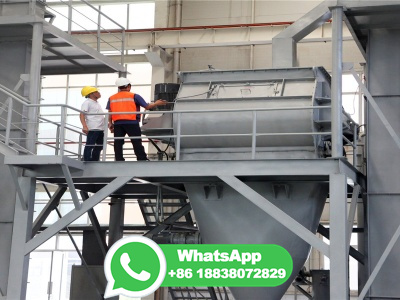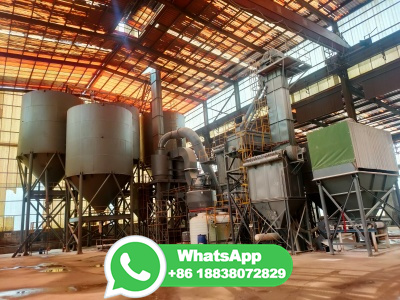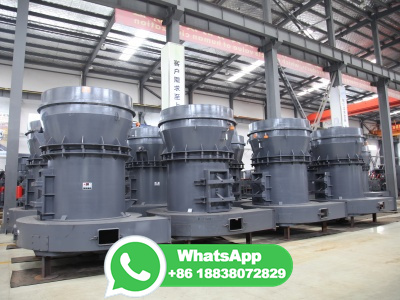
Do you want to know what a steel ball will look like after thousand degrees of treatment? Do you want to know what its used for?What video and contact me ...
WhatsApp: +86 18037808511
Then in ballwear formula (25), T = /K Log10 Da/Db; but from (29), K = Rt/Wt. Then T = /Rt Log10 Da/Db T is 1 day, Wt is the original weight of the ball charge, and Rt is the ball wear for one day. Then Log10 Da/Db = Rt/ are all known, and it is only necessary to solve for Db, the diameter of the balls to be added.
WhatsApp: +86 18037808511
Ball mills and grinding tools Cement ball mills are typically twochamber mills (Figure 2), where the first chamber has larger media with lifting liners installed, providing the coarse grinding stage, whereas, in the second chamber, medium and fine grinding is carried out with smaller media and classifying liners.
WhatsApp: +86 18037808511
Mill Type Overview. Three types of mill design are common. The Overflow Discharge mill is best suited for fine grinding to 75 106 microns.; The Diaphram or Grate Discharge mill keeps coarse particles within the mill for additional grinding and typically used for grinds to 150 250 microns.; The CenterPeriphery Discharge mill has feed reporting from both ends and the product discharges ...
WhatsApp: +86 18037808511
An evaluation of Relo grinding media (RGM, Reuleaux tetrahedronshaped bodies) performance versus standard grinding media (balls) was made through a series of grinding tests, including a slight modification of the standard Bond test procedure. Standard Bond tests showed a reduction in the Bond ball mill work index (wi) of the mineral sample used in this study when using Relo grinding media.
WhatsApp: +86 18037808511
The grinding media may be the ore itself (autogenous grinding), bars, balls, or cylpebs, or even the ore itself together with a small amount of balls (semiautogenous grinding). A survey found out that approximately 53% of the grinding circuits around the world use ball mills, and 38% use autogenous or semiautogenous grinding, and therefore ...
WhatsApp: +86 18037808511
The attritor mill is a wet grinding attrition mill. It differs from conventional ball mills as it uses much smaller media with diameter less than 5mm, leading to greater mediamaterial contact area. Additionally, the attritor mill works at a higher rotation speed up to SPEED.
WhatsApp: +86 18037808511
The grinding media, also referred to as grinding balls or grinding beads, serve as the tools in mills with freely moving grinding media, such as agitator ball mills. The movement of these grinding balls within the mill generates various stresses between the balls and the product, including impact, pressure, friction, and shear. Please accept ...
WhatsApp: +86 18037808511
The size of grinding media is the primary factor that affects the overall milling efficiency of a ball mill ( power consumption and particle size breakage). This article tackles the...
WhatsApp: +86 18037808511
Grinding Media in Ball MillsA Review License CC BY Authors: Nyasha Matsanga Willie Nheta Ngonidzashe Chimwani Preprints and earlystage research may not have been peer reviewed yet....
WhatsApp: +86 18037808511
Figure Displacement of balls in mill. where D m is the mill diameter in meters. The optimum rotational speed is usually set at 6580% of the critical speed. These data are approximate and may not be valid for metal particles that tend to agglomerate by welding. The minimal magnitude of ball size is calculated in millimeters from the equation:
WhatsApp: +86 18037808511
RoM Ball mills, like SAG mills, utilise coarse rocks in the RoM feed as grinding media but with 25 40% steel balls added, which is advantageous when the coarse fraction in the RoM feed is ...
WhatsApp: +86 18037808511
The basic principle of ball mills involves two or more grinding media, such as balls or rods, rotating in a container to grind materials to a desired fineness. The principle of ball mills is based on impact and attrition. The grinding media in the ball mill collide with each other, and the material being ground to produce a fine powder.
WhatsApp: +86 18037808511
To a large extent the focus has been on how grinding media shapes affect milling kinetics in terms of specific rate of breakage and breakage distribution study...
WhatsApp: +86 18037808511
A surface area of grinding media in general, m 2 Ab surface area of ball or sphere, m 2 Ai abrasion index, Alball surface area of grinding ball in laboratory mill, m 2 Arball surface area of grinding ball in industrial mill, m 2 C cost of grinding media per unit mass, /kg CL crop load, % Df final diameter of grinding ball, m Di
WhatsApp: +86 18037808511
Grinding media balls are balls made of a specific type of material that is used in grinding mills and other types of milling equipment. These balls are used to grind, crush, or pulverize materials in the mill, and are made of materials that are resistant to wear and corrosion. Grinding media balls are typically made of a hard, durable material ...
WhatsApp: +86 18037808511
Currently, the cost of steel balls amounts to 45% of the total cost of grinding materials in ball mills (Lameck, 2005). The remaining costs include energy consumption and ball mill lining. Given a high demand for steel balls for balls mills, these balls are now produced on a mass scale.
WhatsApp: +86 18037808511
Ball mills use steel balls as grinding media, and there is point contact between the steel balls. Rod mill. Rod mills usually use steel rods with a diameter of 50100mm as grinding media, and the ...
WhatsApp: +86 18037808511
balls are used as grinding media, the ore itself is used less frequently (31%). The percentage profile of individual mill fillings depends directly on its type. ... located in Kazakhstan, two highpressure grinding rolls for milling and only one ball mill grinding stage were used. The maximum particle size for roll presses in this plant is ...
WhatsApp: +86 18037808511
Alumina Balls and Satellites. Union Process is the one source for 90%, 94%, % and % alumina media. 90% alumina is available in satellites and rod/cylinders. 94% alumina balls have excellent wear resistance with higher impact strength to save running costs with less contamination. They have great wear rate generally better than 90% or 99 ...
WhatsApp: +86 18037808511
Three levels of steel balls of mm, mm, mm and mm diameters were used as the grinding media. The filling levels M* was taken as 30%, 40% and 50% of full mill and the mill speed N* was selected as, and of the critical speed. ... It has been shown that the grinding of ball mills of different sizes follows the ...
WhatsApp: +86 18037808511
This study investigated ultrafine coal grinding performance of four low to moderatecost grinding media in a laboratory stirred mill. ... Four NEUM850 ceramicmedium stirred mills superseded the ball mills of second and third stage in the Aoshan concentrator, and the grinding unit consumption decreased by %. ...
WhatsApp: +86 18037808511
The attrition mill agitator rotates at speeds ranging from 60 rpm for production units to 300 rpm for laboratory units and uses media that range from 3 to 6 mm while ball mills use large grinding media, usually 12 mm or larger, and run at low rotational speeds of 1050 rpm. Power input to attrition mills is used to agitate the medium, not to ...
WhatsApp: +86 18037808511
The aim of this study is to evaluate the effect that the size of grinding media exerts on ferronickel slag milling efficiency and energy savings. A series of tests were performed in a laboratory ball mill using (i) three loads of single size media,, 40,, and mm and (ii) a mixed load of balls with varying sizes. In order to simulate the industrial ball milling operation, the feed ...
WhatsApp: +86 18037808511